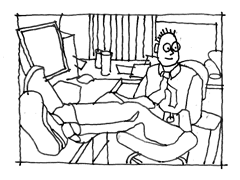Hanging with Hafen: Cut to the chase with your contractor
Stop wasting your time fussing over trivial things and start learning how to coexist peacefully with your construction team. Get to the meat of important conversations to keep your project on track.

Remember the Paris Peace Accords? The year was 1973 and the North and South Vietnamese were hunched around a table trying to negotiate an end to the Vietnam War. And like the war itself, it was a long, painful process. In fact, what I remember most about the talks was the four months the opposing sides spent discussing the shape of the negotiating table!
Speaking to a contractor recently, I was reminded of these talks. Not of the war itself, thankfully, but to the argument about the shape of the table. Sometimes it seems we spend all of our time and effort negotiating the shape of the table while the war (or the building construction) spins on. Here are a few lessons I've learned over the years while observing these battles.
Lesson 1: Don't sweat the small stuff
We were working on a project down south. From our perspective it wasn't a very big project-about 5,000 square feet-but to the client, it was significant. After all, this was the first clinic he had built, and he was prepared to sweat the details.
On one of the first days of construction I got a call from the contractor telling me that the owner had thrown a fit over some concrete work that was not done right. From the call, I couldn't tell if the concrete work was right or wrong, but I did assume that the scale of the potential screwup did not match the client's reaction. In short, something just didn't make sense.
It was kind of like the Paris Peace Accords, but instead of negotiating the shape of the table, the owner and the contractor had set it on fire. In my short conversation with the contractor, I knew we had already reached the tipping point and we needed a solution to our problem-fast.
Lesson 2: Building construction mirrors life
Building a veterinary facility is much like life itself, just more condensed. In life, people are defined by directions, desires, agendas and needs. All of these can combine to create a wonderful existence or a toxic mess. Building a facility is the same thing. With a good set of drawings, construction should be simple. After all, everything that matters is already written down in the drawings-all the contractor has to do is follow directions. But for those of you who have undertaken the task, you know that building a facility is a heck of a lot more complex than that. Almost everything about the construction process is a gray zone.
In construction, you need to give yourself room to deal with the things that have not gone wrong, but that may later on. If from the start you assume the other person is a screwup or is trying to do you in, you've already lost objectivity, and as such, the chance that you may successfully negotiate the situation is remote. And worse yet, you've used up a tremendous amount of the negotiating room you may need in the future.
Lesson 3: Burning bridges can come back to haunt you
In another instance, I was talking with a fellow worker about her negotiations with a contractor over the roof on a project. We had drawn one thing, and now we needed to change it to something else. But the contractor and my coworker had spent the last couple of weeks attempting to negotiate the “shape of the table.” And now that it was time to sit down and decide on the important things-namely, how to you keep the rain off their heads-the two of them had used up all their goodwill. It wasn't anybody's fault, but instead of reaching a consensus on the shape of the table, they had been chasing each other around the table. When the final push came, they couldn't come together.
Looking at these two recent encounters along with the Paris Peace Accords, it seems to me that every interaction starts without an agenda or prejudice. In early negotiations, two people have a blank slate that should allow discussion to range in any direction that will lead to a more meaningful dialogue. The trick is to not start inadvertently nibbling away or, worse, actively working to destroy that baseline. For negotiations to be fruitful, they have to have direction and purpose. So don't get buried in irrelevant details, like the shape of the negotiating table. But you also need to allow for “sidebar” issues that may come up without straying too far from the agenda.
Most importantly, successful negotiations must transcend the shape of the negotiating table. They need to be based on mutual respect and even empathy. Successful negotiations require that you to give the other person space at the table, and that you stay on task.

Veterinary Economics Editorial Advisory Board member Mark Hafen, AIA, is a founding member of veterinary design firm Animal Arts in Boulder, Colo.